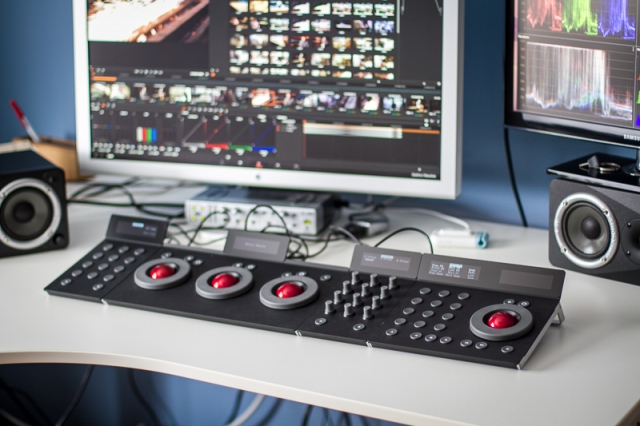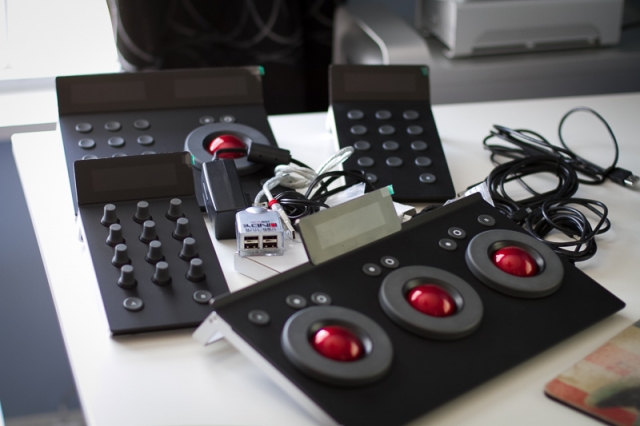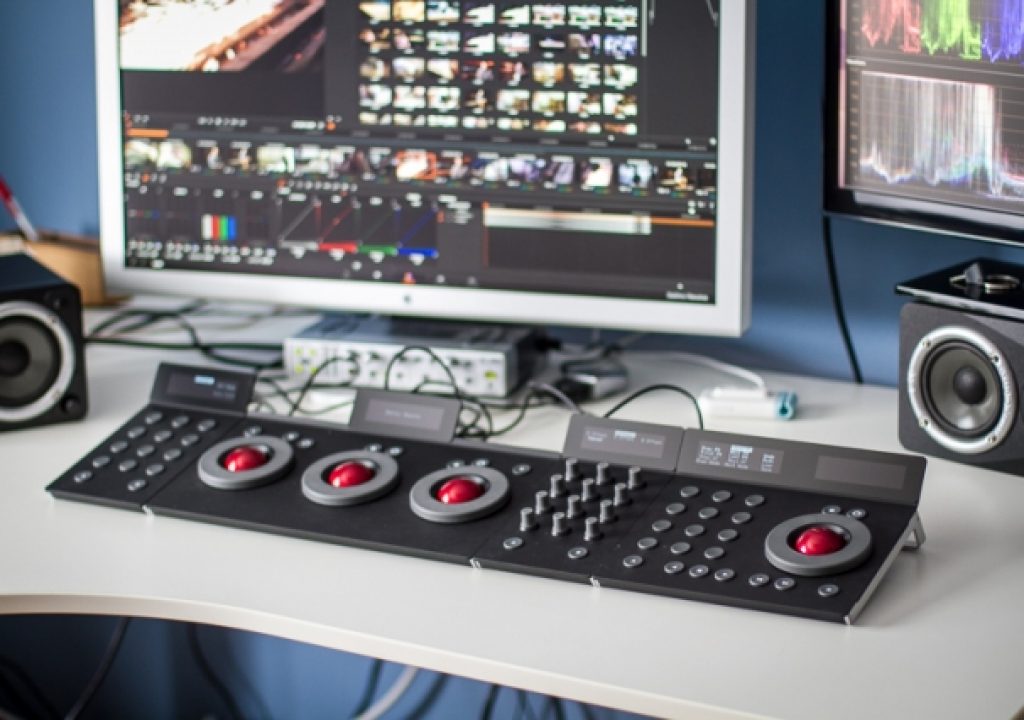If you’re an editor these days then you’re probably asked to do some color correction and color grading. In fact you might not ever have the luxury of sending a program out to a dedicated colorist. Chances are you also make use of DaVinci Resolve for many of those color grading tasks as it works amazingly well and the very powerful lite version is free. Those using Resolve and any other number of color grading tools will definitely find that a dedicated control surface like the Tangent Element is a luxury that will make that color work a lot more fun and productive.

The Element is a very nice looking unit that any editor would be happy to display in their suite.
We’ve looked at other color grading surfaces before here in the Editblog labs. There was (and still is) the Tangent Wave, a $1,500 hunk of plastic that while large will make working in Resolve (or Adobe Speedgrade) a much better experience. There’s also the Avid Artist Color. The Artist Color surface will interface quite nicely with Resolve (it’s priced around $1,500 but can be found for a bit less) and has also been adapted to work with Avid Media Composer as well. Both of those surfaces have been around for years.

Before it’s all set up you’ll probably take an inventory of all you need to make it work. There are a lot of wires so some cable management is necessary.
Tangent introduced the Element a couple of years ago and the design, coupled with the excellent overall feel, made them an immediate hit, especially when compared to the plastic Wave. The Element takes a different approach to an affordable control surface than the Wave in that it’s a modular unit consisting for four different panels. Buy them all and you’re looking at spending around $3,400 so they are a lot more expensive than the Wave. But what you can also do is buy them in pieces. This is true for most host applications so be sure and check the fine print before you only buy one.
The element-Bt is a 12 button panel with two banks. That costs $695 (these are all B and H prices).
The element-Tk is the set of three trackballs and rings that costs $1,195.
The element-Kb is 12 knobs set with two banks for $895.
The element-Mf is a multifunction unit with 12 buttons (two banks there as well), a trackball and ring (usually for jog shuttle control) and playback transport controls that is priced at $1,095.
Buy them as a set: $3,495.
Each of the four units get their own USB connection and each unit serves a different function. I mainly used the Element with Resolve so that’s what we’ll cover in this article.
You’ll have to contend with a cable running from each unit to a USB hub. Not a big deal but something to be aware of when it comes to cable management. Editors have a lot of cables to manage.
DaVinci Resolve has rather good keyboard controls. At least that’s how it appears to me as an editor who has to take the occasional trip into Resolve. Yes all the NLEs have good color grading tools these days but none of them seem to be able to pull out an image quite as good looking as you can in Resolve. Plus there’s a lot more tools in Resolve when it comes to curves and secondaries (among other things). While those Resolve keyboard controls are nice the Element aims to put many of them front and center.
The Element's look and feel
The trackballs are single most useful part of the whole Element set. At least that’s the part I seemed to spend most of the time on and the part of the set that is the most fun to use.
The most dramatic part of any control surface are the three trackballs and rings. They are designed to all three work together when adjusting the lift/gamma/gain controls (as in the case of the rings) or the color wheels (as in the trackballs). All of these grading controls can easily be adjusted with the mouse but those adjustments happen one parameter at a time and often one adjustment affects another. A control surface with the three trackballs and rings make those adjustments much more fluid. They give a lot more control and make the whole grading process quite a bit more interactive … and fun.
Two of the units are composed of a lot of buttons. They all represent something in the Resolve interface or some command. By having both an A and B bank on each unit of the Element you effectively double the number of controls per unit.
The second most used part of the Element set for me is the knobs. These images look quite a bit more dusty than the units appeared sitting on my desk. While the black surface does show dust quite a bit it wasn't as bad as these images seem but the rubberized flat surface of the Element isn't as easy to dust as hard plastic.
Buttons are nice to get as part of a color grading control surface but the knobs are probably a bit more useful. They control things like power window parameters for pan, size and rotation to name a few. If you were making an extreme rotation to a power window the twirl of a knob makes it much faster, easier and more interactive than a click and drag of a mouse. If you get it wrong just push down on the knob to reset the parameter. You also don’t have to spend as much time looking down to see exactly where in the Resolve interface your mouse pointer is. As long as that parameter is active in the Resolve interface and on the Element surface you can adjust that parameter.
The units are packed well so save those boxes if you ever need to transport them or ship them to another location.
The build quality of the Element is fantastic. It has a much different build than that of the all plastic Tangent Wave. Metal abounds in the Element’s construction with knobs and rings feeling very tight. There is a good weight to the four different Element units as well so they aren’t going to scoot around on the desk. The Tangent Element website goes into more detail about the construction as well as dimensions. All four panels will take up some desk space. You’ll also need four USB connections so you’ll have to plan for that with a USB hub which isn’t normally included as part of a bundle. Thankfully they don’t require any external power as that comes through USB.
The rings are held on magnetically and can be removed for easy cleaning.
I’m looking at this surface from the standpoint of an editor so chances are you’re not going to need the control surface out all the time as that’s not the primary focus of your work. The full Element set is a bit unwieldy to move on and off you desk on a regular basis and unless you have a large editing desk you’re probably not going to want to leave them out all the time. That’s not because they aren’t nice to look at but more that they take up a lot of room. When compared to the Tangent Wave (which is actually quite a bit deeper) moving the entire Element does take more time and effort which is understandable since there’s so much more to the Element.
The little box that comes with each unit contains the USB cable and the magnets. The little bag holds those little magnets until you use them.
The four Element units can be magnetically connected with tiny little magnets that fit into little holes on each side of each unit. It’s a clever solution to keep them together and it allows you to rearrange them to your liking. You just have to be sure you keep up with the little magnets if you move it around a lot.
The controls aren't customizable in Resolve.
If you’ve used the Tangent Wave before then you’re probably familiar with the Wave Control Mapper software that lets you custom map many of the buttons for the Wave. The Element has no such option when working in Resolve. On the one hand, this would be mapping overkill as there are so many buttons on the Element and so many functions in Resolve you could spend months trying to map it out. On the other hand, customization is a good thing and it would seem this is something people want. If you dig around some forums you’ll find this very discussion and there are a lot of users who want custom button mapping options. Some think the mappings are clumsy. Is the lack of mapping because Blackmagic wants people to buy the big $30,000 panel? That seems unlikely given the limited market of that panel but it does seem odd you can’t even map something like transport control unit as the very least. As one who remaps basic NLE keyboards like mad it seems like a real oversight that you can’t remap the Element for Resolve. This is most likely a Blackmagic decision and not Tangent.
To get a good overview of the Tangent Element in Resolve then check out this video from the great color grading education website Mixing Light: Using the Tangent Element with DaVinci Resolve 10.
There has been one update to the Element control mappings and this blog post goes over them in great detail including screen shots of all the different Element screens. You can see from scrolling down that page that there are a lot controls you can manipulate with the Element.
As far as my thoughts on the current functions, they all seem pretty usable to me but I don’t spend all day in Resolve. I did notice several places where I felt like I was constantly hitting two or three buttons to jump between different menus to get to a Resolve function I was using over and over. But that same thing happened with the Wave. The Element screen is divided into a grid that corresponds to the knobs and buttons on the panel. I found a couple of instances where there was a blank knob or button say on the right of a panel and the next usable knob was one row below. That seemed odd but it may be because of the way the engineers wanted them grouped.
This grid on the display corresponds to the knobs below the display. 12 quadrants on the grid, 12 knobs on the panel.
Resolve gets regular updating. Blackmagic just updated to 10.1 so they are constantly improving the software. Tangent doesn’t update the Element’s control mappings nearly as often but since they have updated them in the past I would hope they would continue to in the future.
Do you need all 4?
Since the Element is made up of four separate panels that are also sold separately that begs the question of do you really need all four of them. Obviously they were all designed to complement each other with individual panels offering a specific type of control. Leave off the element-Kb and you have a lot less knobs to twirl (note that Tangent says in Resolve “if you buy the Kb panel you must buy the Bt panel”. Leave off the element-Mf and there goes your transport control. But perhaps the most useful of the bunch is the element-Tk with the three trackballs and rings. Could a user get away with only spending the $1,200 on the trackball panel? Of course and that’s what some users seem to be doing.
You don’t have to connect the four panels with the magnets. I found I liked to have them separated as in the picture above.
This might be the smart buy for the editor who only has to make the occasional trip into Resolve. While it’s certainly a nice, fun luxury to have the entire set of panels if you spend most of your time in an NLE and not Resolve you could easily set aside the trackballs when you’re not using them. Plus Resolve has some good keyboard controls so there’s a lot you can do from the keyboard you already have sitting there. It’s the trackballs and ring interaction that is truly the best part of any color grading surface so having that single panel available will save time and a lot of mouse clicks when working in Resolve. The best part of trackballs and rings are that you can move more than one parameter at a time so your ultimate result might be a bit better than if you were tying to get that from a mouse. Easier, faster and more fun means you might experiment more or add that extra level of tweaks to an image.
Here’s an interesting question if you’re thinking of buying only the element-Tk trackball unit:
Do you spend $1,195 on just the Element trackballs (that B&H price might be a bit lower when you add it to your cart) or pony up $1,595 for a Tangent Wave to add buttons, knobs and a lot of plastic to the mix? That’s a tough call. I think as an editor I would choose the Wave. That would give me more controls that just the Element trackball panel. That’s an editor talking where you spend a lot less time in Resolve than a colorist. But if you were to purchase just the Element trackballs panel you’d always have the option to go back and add more panels in the future. Once you feel how nice the element-Tk panel is you might be tempted to do just that.
If you are spending more time in Resolve and thinking about a Wave purchase then you owe it to yourself to seek out both the Wave and Element and compare the look and feel. It’s no question that the Element is much more solid with a higher build quality which is to be expected since the Element is a higher end panel. While the knobs seem to be the same general design overall you can’t accidentally change a setting when you bump a knob with the Element. I found that happened a lot with the Wave. And that Element set just looks a lot more impressive sitting on a desk than the Wave. That might be important if you have clients sitting in with you.
Other software support as well.
Of course the Elements supports Adobe SpeedGrade.
I only really used the Tangent Element with Resolve but the unit supports a lot of other software as well. The Applications page lists all that is supported as well as how user mapping of the buttons works if that is at all possible. Some software allows for internal mapping instead of the Tangent Mapper. Much of the supported software is more speciality, high end tools but note that there is support for Adobe Speedgrade.
As in Resolve you just can’t remap the buttons in SpeedGrade.
Once again the good folks at Mixing Light come through with Using the Tangent Element in SpeedGrade CC. Thats important as Adobe continues to improve their color grading tool.
The Element works very well with the Baselight Editions plug-in.
The other support that I tested was Baselight for Avid. That’s a very powerful color grading plug-in for Avid Media Composer (and a few other applications) that is a mini-Baselight right inside the NLE interface. If you’re using this powerful color grading plug-in then you’ll benefit greatly from a control surface. The response to the Baselight for Avid plug-in was very good.
Pros
- Excellent feel and great build quality
- Modular design means you don’t have to buy all four units
- It’s just fun to use when color grading
Cons
- No custom button mapping in DaVinci Resolve or Adobe SpeedGrade
- 4 USB connections might mean some desk clutter
- It takes some work to move it off of a desk
Buying Advice for the Editor
For the editor, a color grading control surface of any kind is a luxury more than a necessity. Since you’ll be spending a minimum of around $1,500 that’s a decision you’ll have to make for yourself. Editors often have to do color work as part of the overall post-production package of a job so it might not be something you can bill for directly but if you’re doing a lot of color work the time you save might be worth it. As and editor I think I would still spend my money on a Tangent Wave. It's cheaper, very functional and easy to get on and off the desk. But one thing is for sure, it's not a cool looking as the full Element set.


